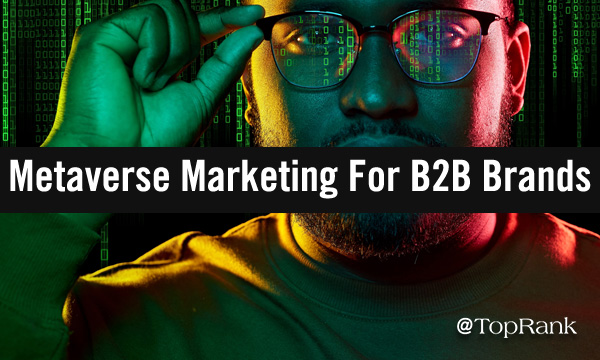
 The metaverse — a term coined in a 1992 novel — isn’t done cooking yet, but with a world that needs to eat right now and chefs that need to cook, what do B2B brands need to know to get ready? Just 18 percent of brand marketing and analytics executives said that they understood the metaverse and how it will affect their brand, according to recently-released survey data.
The metaverse — a term coined in a 1992 novel — isn’t done cooking yet, but with a world that needs to eat right now and chefs that need to cook, what do B2B brands need to know to get ready? Just 18 percent of brand marketing and analytics executives said that they understood the metaverse and how it will affect their brand, according to recently-released survey data. 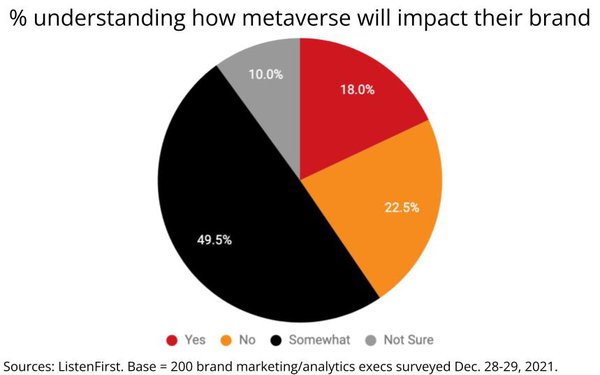 Despite limited general understanding of just what the metaverse is and may become, the areas that it will encompass are vast, running the gamut from digital currency and assets and natural language processing to device independence and marketplace commerce, as Gartner recently outlined.
Despite limited general understanding of just what the metaverse is and may become, the areas that it will encompass are vast, running the gamut from digital currency and assets and natural language processing to device independence and marketplace commerce, as Gartner recently outlined. 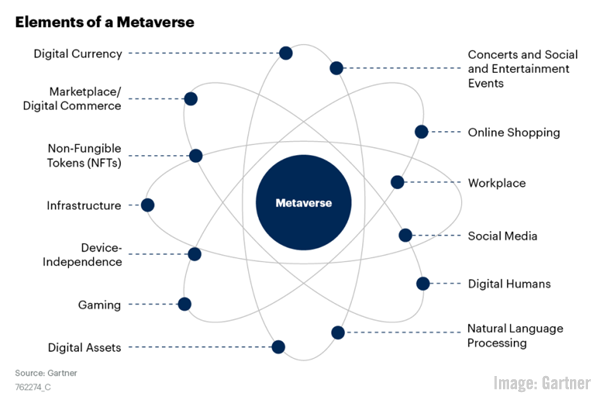 Let’s warp right in and explore five ways that B2B brands can succeed with metaverse marketing, and the pitfalls that savvy marketers must watch out for.
Let’s warp right in and explore five ways that B2B brands can succeed with metaverse marketing, and the pitfalls that savvy marketers must watch out for.
1 — Moving Past A Disconnected Hodgepodge
The metaverse is currently a disconnected hodgepodge of holographic hopes and digital dreams that may or may not eventually reach the sustainable velocity to capture the hearts, minds, and wallets of the public and private sectors. As someone who’s been around online communications for over 38 years now, it’s hard to not see the metaverse as just another “cyberspace / next big thing” and a variation on a theme already played out by virtual reality (VR) and augmented reality (AR), however it’s undeniable that the theoretical promises it holds true could indeed be achievable if the digital stars precisely line up. Otherwise, the metaverse may face a scenario that marketing cartoonist Tom Fishburne recently summed up in his Marketoonist piece, “The Future of the Metaverse.”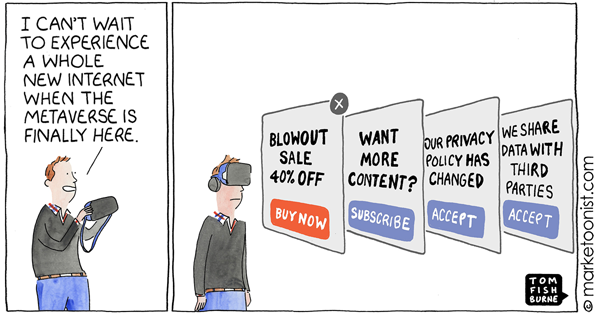
2 — Avoiding The Siloed Platform Trap
A primary danger the metaverse faces is falling into the siloed social media platform trap, with walled gardens of innumerable metaverse-like instances each owned by separate entities and all not being able to — whether on purpose or otherwise — talk to one another, or even willfully trying to prevent people from leaving their particular slice of metaverse pie. Despite this danger, as we covered in our weekly Friday B2B marketing news, predictions for adoption of the metaverse have shown swift embracing of the technology. 30 percent of global organizations will offer products or services through the metaverse by 2026, while 25 percent of people will utilize at least an hour each day using metaverse technology, and while it won’t be owned by a single vendor, the future metaverse will likely boost engagement even among enterprise users, according to the Gartner report data. When it comes to what marketers think about the metaverse, one recent survey found that some 55 percent of marketers said that the metaverse will have a positive impact on marketing, with 11 percent seeing it as having a negative effect, while 34 percent remained neutral on the question.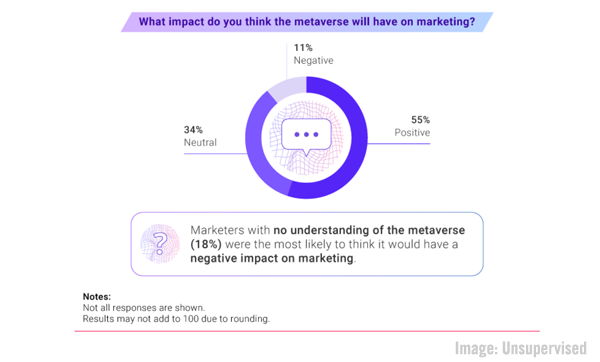 Other survey data has shown that those in younger demographic groups have already begun to spend more time using existing forms of the metaverse. Gen Z consumers interact socially in the metaverse twice as much as in real life, the study showed. Additional recent survey data showed that 36 percent of U.S. adults said that they were interested in the metaverse, while 56 percent of millennials and 51 percent of Gen Z consumers expressed interested. [bctt tweet="“A primary danger the metaverse faces is falling into the siloed social media platform trap, with walled gardens of innumerable metaverse-like instances each owned by separate entities not willing to talk to one another.” — @lanerellis" username="toprank"]
Other survey data has shown that those in younger demographic groups have already begun to spend more time using existing forms of the metaverse. Gen Z consumers interact socially in the metaverse twice as much as in real life, the study showed. Additional recent survey data showed that 36 percent of U.S. adults said that they were interested in the metaverse, while 56 percent of millennials and 51 percent of Gen Z consumers expressed interested. [bctt tweet="“A primary danger the metaverse faces is falling into the siloed social media platform trap, with walled gardens of innumerable metaverse-like instances each owned by separate entities not willing to talk to one another.” — @lanerellis" username="toprank"]
3 — Metaverse Content Is Still King
When new technology such as the metaverse comes along it can be helpful to keep some enduring digital marketing truths in mind, particularly the one our own CEO and co-founder Lee Odden shared years ago, “Content is the reason search began in the first place.” The metaverse — just like a search engine — is empty without content, in the same way that social media platforms and web properties would be empty wastelands without the digital lifeblood of content. Great content can be smoothly adjusted and messaged to succeed in virtually any medium or format, so brands that are creating winning content are already poised for doing well in the metaverse. As the currently chaotic metaverse evolves, brands may face the need to format multiple versions of the content they want to share, each tailored to a specific flavor of metaverse — a solution that while certainly not ideal, gives brands the opportunity to test the waters and compare engagement levels within each metaverse incarnation. Even with the right content at the right time, if the metaverse doesn’t achieve the cohesion it needs to achieve business buy-in and mainstream acceptance, it runs the risk of being relegated to the “Metaverse Hype Cycle,” at Tom Fishburne examined in another recent Marketoonist cartoon.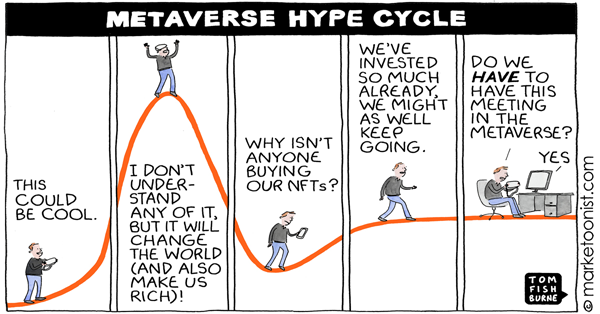 Adobe’s 2022 creative trends forecast — from the innovators at its Adobe Stock arm — included the metaverse among its key motion trends for the year ahead, alongside its “otherworldly visions” design trend. We explored this and other top B2B marketing design trends recently in, “Visual Focus: The Digital Designs Propelling B2B Brand Success In 2022.” [bctt tweet="“Great content can be smoothly adjusted and messaged to succeed in virtually any medium or format, so brands that are creating winning content are already poised for doing well in the metaverse.” — Lane R. Ellis @lanerellis" username="toprank"]
Adobe’s 2022 creative trends forecast — from the innovators at its Adobe Stock arm — included the metaverse among its key motion trends for the year ahead, alongside its “otherworldly visions” design trend. We explored this and other top B2B marketing design trends recently in, “Visual Focus: The Digital Designs Propelling B2B Brand Success In 2022.” [bctt tweet="“Great content can be smoothly adjusted and messaged to succeed in virtually any medium or format, so brands that are creating winning content are already poised for doing well in the metaverse.” — Lane R. Ellis @lanerellis" username="toprank"]
4 — Hold Tight & Keep Up For A Wild Metaverse Ride
Brands not quite ready to enter one of the nascent available metaverse test-beds can hold tight and keep watch on how the technology plays out, while keeping potential metaverse-friendly content in mind to begin trying out in the format once the time is right. Brands can assure readiness for their eventual participation in each variety of the metaverse by registering accounts with the current crop of top players in the technology, to reserve the organization’s name in at least a placeholder state. Global banking giants JPMorgan Chase and HSBC are two of the major firms that have already begun scoping out territory within the metaverse, as Rachelle Akuffo explored recently in “Companies are betting big on real estate in the metaverse.” Akuffo makes mention of “the various metaverses that are being developed,” which points to the disjointed nature of our current metaverse. Meta — the parent company of Facebook and Instagram — besides choosing a name that evokes the metaverse, has heavily invested efforts in the metaverse, which has led many to assume that “the metaverse” is an extension of Facebook. It’s also paved the way for advertisers to be a part of its particular implementation of the metaverse, as Sheila Dang recently outlined for Reuters in “Meta inks partnership for 3D ads in step toward the metaverse.” Virtual metaverse classes were also among the initial areas that will be tested within Meta’s Horizon Worlds VR platform, as outlined in an additional recent Reuters report.5 — Heed History’s Lessons And Sir Tim’s Take
via GIPHY When Sir Tim Berners-Lee invented the Web, as we detailed in "Classic Marketing Insights to Celebrate the Internet’s 50th Birthday," one of his biggest goals was to make it easier for people to find information on the Internet — an ambition that has undoubtedly seen tremendous success perhaps beyond any other technology in history. In recent years he’s been involved in Solid, a decentralized open-source data-storage technology developed by Inrupt, a firm he co-founded. “People ask about virtual reality, and if the metaverse is going to be the whole future, and the answer is that it’s going to be part of the future,” Berners-Lee recently observed in Nate Lanxon’s Bloomberg article, “The World Wide Web’s Creator Wants Metaverse VR.” [bctt tweet="“People ask about virtual reality, and if the metaverse is going to be the whole future, and the answer is that it’s going to be part of the future.” — Sir Tim Berners-Lee @timberners_lee" username="toprank"] “If we do build 3D worlds let’s build them so that I can put a 3D world on my website and you can put one on your website and using VRML we can have a portal so that people can wander around my world and then go through on the open web to join these 3D worlds together without having to go through any one central place,” Berners-Lee recently suggested in Ann-Marie Corvin’s TechInformed article, “Berners-Lee describes his vision for a joined-up metaverse – and it’s decentralised” “Persuading people to do things a different way is really hard,” Berners-Lee also lamented. Berners-Lee’s cataclysmic web was significantly helped along by the standards organization known as the World Wide Web Consortium, and a small but growing number of technology experts have expressed hope that similar oversight and guidance can still be applied to the metaverse. “No single company should ever exert control — it’s simply too important for that to happen,” David Reid, professor of artificial intelligence (AI) and spatial computing at Liverpool Hope University recently shared with Martyn Warwick in a TelecomTV piece, “Self-regulation just won’t cut it in the metaverse – it needs a virtual Interpol.” Protecting privacy, preventing abuse, ensuring interoperability, and enabling access are the four key issues the metaverse faces, according to Berners-Lee’s World Wide Web Foundation — the non-profit organization he founded in 2009 — as outlined in Kara Dunford’s “The metaverse: a bold, exciting digital future or a digital dystopia like we’ve never seen before?” “It’s important that the metaverse is built as an open plain rather than a walled garden, with no one company at the helm. There will be no one single metaverse — but rather many metaverses,” Dunford noted. “We need common standards and interoperability to bridge between these spaces, so that we don’t end up with separate digital confines but can instead travel seamlessly between virtual spaces with the same avatars and other digital assets,” Dunford added. An additional movement seeking to play a role in shaping the future of the metaverse is the Web3 concept, which looks to incorporate elements of blockchain technology, as Cathy Hackl, chief metaverse officer at Futures Intelligence Group recently explored in the Forbes article, “An Evolving Strategy For The Emergent Metaverse: A Web3 Manifesto For Brands And Artists.” “Web3 is a collective evolution in experiences between brands, artists, and audiences,” Hackl noted, adding that it’s also “an evolving framework that defines a brand’s relationship with this new capability.” She also sees a Web3-shaped metaverse giving brands, “An opportunity to expand their audience, deepen the connection with their existing audience, or even a way to engage with a completely new audience.” We’ve featured Hackl several times on the TopRank Marketing blog, including “Augmented Reality: How to Leverage AR in Marketing With Cathy Hackl.”Tune In To The Metaverse’s Universal Marketing Music
via GIPHY What does this all mean for B2B marketers? While the metaverse is still at least somewhat in its wild west stage, B2B marketers should keep in mind the developments it’s currently going through that we’ve outlined, and keep up with the changes that it will inevitably see in the near future. Whether you are just testing the metaverse waters for B2B brands, making the decision to go all-in, or taking a wait-and-see approach will be a choice each brand needs to make, and whichever you choose we hope that the information we’ve explored will help in making an informed decision. In today’s digital-first landscape, creating award-winning B2B marketing requires considerable time and effort, which is why more firms than ever are choosing to work with a top digital marketing agency such as TopRank Marketing. Contact us to learn how we can help, as we’ve done for over 20 years for businesses ranging from LinkedIn, Dell and 3M to Adobe, Oracle, monday.com and others.The post 5 Timely Ways B2B Brands Can Conquer Metaverse Marketing appeared first on B2B Marketing Blog - TopRank®.
0 Commentaires